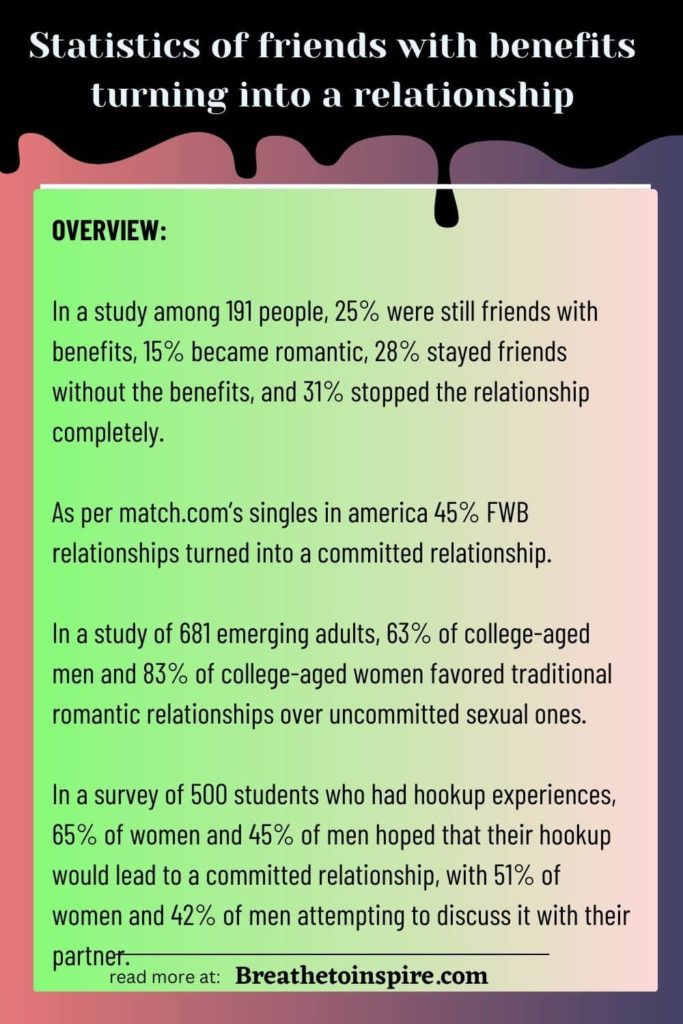As the concept of friends with benefits becomes increasingly popular, many people wonder if these casual relationships have the potential to turn into something more serious.
To answer this question,
Numerous surveys, studies, and research have been conducted to shed light on the statistics of friends with benefits turning into a relationship.
I have come across various findings related to the subject matter. While the statistics may vary depending on the source, one thing is clear – the transition from friends with benefits to a real relationship is possible.
However, it’s essential to note that not all friends with benefits relationships lead to a romantic relationship.
In this blog post, we’ll be exploring some of the research and surveys conducted to determine the likelihood of a friends with benefits relationship transitioning into a romantic relationship.
Whether you’re considering entering into a friends with benefits relationship or are already in one and wondering where it may lead, this post will provide valuable insights into the topic. So, let’s dive in!
- Statistics of friends with benefits turning into a relationship
- In a Longitudinal study about friends with benefits 15% turned into a relationship
- As per match.com’s singles in america 45% FWB relationships turned into a committed relationship
- In a study of 681 emerging adults, 63% of college-aged men and 83% of college-aged women favored traditional romantic relationships over uncommitted sexual ones.
- How do friends with benefits turn into a relationship?
Statistics of friends with benefits turning into a relationship

In a Longitudinal study about friends with benefits 15% turned into a relationship
Researchers asked 191 people aged 30 on average to take part in a 2020 longitudinal study about “friends with benefits” relationships. The people were mostly female (70%), white (74%) and heterosexual (72%). They had known their friend with benefits for about three years before the study.
The first survey asked what they wanted from the relationship, how satisfied they were, and how much communication they had about the rules.
The second survey, after a year, asked how the relationships had changed. It turns out that their wishes only matched the outcome of the relationship 17% of the time.
25% were still friends with benefits, 15% became romantic, 28% stayed friends without the benefits, and 31% stopped the relationship completely.
Those wanting to stay friends were the most successful in getting their wish (59%), while those wanting to enter a romantic relationship were the least successful (15%).
Also read: 50 Signs your fwb is jealous
As per match.com’s singles in america 45% FWB relationships turned into a committed relationship
According to Match.com’s Singles in America website statistics, 55% of singles have experienced a friends-with-benefits relationship, and 45% of them have seen it end up in a long-term committed relationship.
Similarly, 40% of singles have had a “casual sex” relationship, and 29% of them have transitioned into a romantic relationship.
This is because when you are friends with someone, you already have a connection. That connection grows when you start having sex.
In contrast, when you just have casual sex partners, you don’t have a connection and it’s more about the sex rather than the feelings.
Also read: Why my fwb is confusing me? (20+ reasons, signs, tips to handle the situation)
In a study of 681 emerging adults, 63% of college-aged men and 83% of college-aged women favored traditional romantic relationships over uncommitted sexual ones.
In a publication by The Kinsey Institute for Research in Sex, Gender, and Reproduction entitled “Sexual Hookup Culture,” it was reported that men generally have more sexual partners, give consent to sex faster than women, and invest fewer resources in non-long-term partners.
On the other hand, women are more likely to seek long-term relationships to benefit their offspring, and in some cases, may engage in short-term relationships to gain access to better quality genes.
Sexual strategies theory proposes that both genders may engage in long and short-term relationships, but for different evolutionary reasons.
A survey conducted in North America found that 65.2% of men and 45.4% of women actively seek short-term mates.
Among single people, the numbers increased to 79.3% for men and 64.0% for women. These findings suggest that sex-specific mating strategies have an adaptive nature, as concluded by evolutionary-inclined researchers.
Among 681 emerging adults in a study, 63% of college-aged men and 83% of college-aged women preferred traditional romantic relationships over uncommitted sexual ones.
In a survey of 500 students who had hookup experiences, 65% of women and 45% of men hoped that their hookup would lead to a committed relationship, with 51% of women and 42% of men attempting to discuss it with their partner.
While gender roles in hookup culture show slight differences, the curves overlap significantly.
In a study on the motivations for hookups, Garcia and Reiber (2008) found that many young people desire hookups for physical pleasure.
However, some also want an emotional connection and even hope to start a romantic relationship.
Specifically, 89% of women wanted physical pleasure, 54% wanted emotional pleasure, and 51% of women hoped to start a romantic relationship.
Also read: 20 Very subtle signs your friends with benefits is falling for you
How do friends with benefits turn into a relationship?
As per yourtango, Damian J. Sendler, Ph.D, who is the director of clinical research programs at Felnett Health Research Foundation, suggests that a potential indication of moving towards a committed relationship could be the increase in text messages or frequent calls from your fling.
In addition to an increase in text messages and calls, there are other signs that your casual fling may be turning into a committed relationship.
One common indication is spending more time together outside of the bedroom. This could mean going on dates or doing activities together that are not solely focused on sex.
Another sign could be introducing each other to friends and family. This is a clear indication that the two of you are starting to view each other as more than just casual partners.
You may also find yourselves having deeper conversations about personal goals, values, and aspirations.
From my perspective, it’s important to communicate with your partner about the direction you both want the relationship to take.
It’s possible that you both may have different ideas about what you want, and it’s important to be clear about your own intentions and listen to your partner’s feelings as well.
It’s also important to be aware of your own emotions and be honest with yourself about whether you are truly ready for a committed relationship.
It’s okay if you’re not, but it’s important to be upfront about that with your partner to avoid any confusion or hurt feelings.
Ultimately, the transition from a casual fling to a committed relationship can be exciting, but it’s important to navigate it with open communication, honesty, and respect for each other’s feelings and intentions.
Also read: How to turn friends with benefits into a relationship? (7 steps & 3 tips)
Final thoughts:
In conclusion, while the statistics of friends with benefits turning into a relationship may vary, it’s clear that communication and spending time together outside of sexual activity are crucial indicators of a possible transition towards a romantic relationship.
While not all friends with benefits relationships lead to something more, it’s essential to be honest and open with your partner about your intentions and feelings.
With mutual respect and communication, a friends with benefits relationship can potentially turn into a loving and long-lasting relationship.
